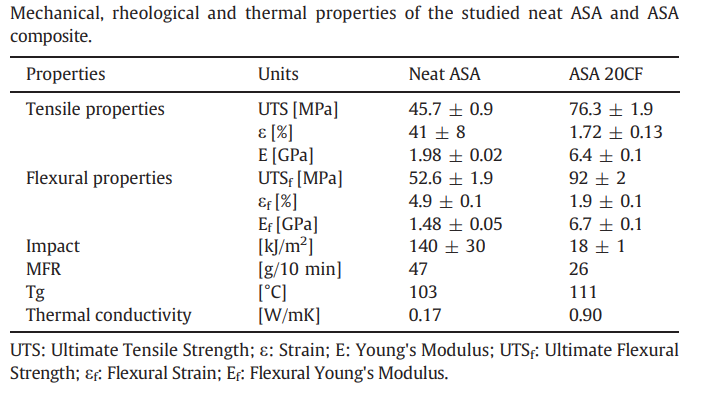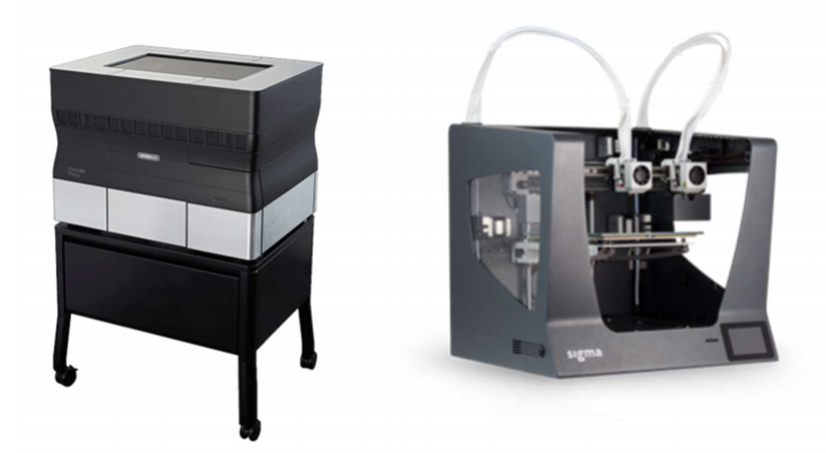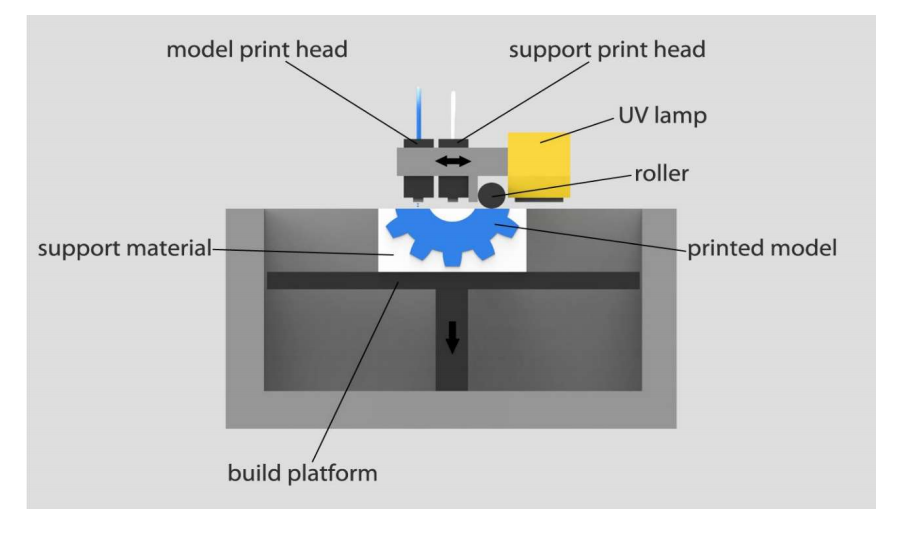Researchers from Spain are studying materials for more effective large-scale 3D printing, outlining their findings in the recently published ‘Development of carbon fiber acrylonitrile styrene acrylate composite for large format additive manufacturing.’
While 3D printing on the micro- and nanoscale is extremely popular among researchers today, the authors point out that large format additive manufacturing (LFAM) for the industrial user is usually centered around the fabrication of parts that may reach several cubic meters. For this type of production, 3D printers must be accompanied by optimized materials that are suitable for service requirements yet demonstrate high printability.
Today, acrylonitrile styrene acrylate (ASA) is a thermoplastic often being used in LFAM due to excellence in mechanical properties and wettability. ASA also has very good weather resistance and is already used widely in automotive and outdoor applications. Similar materials such as acrylonitrile butadiene styrene (ABS) are extremely popular too due to strength, stiffness, and processability.
“Other technical materials such as polyphenylene sulfide (PPS), polyphenylsulfone (PPSU), polyamide (PA), polyether ether ketone (PEEK) or polyethylene terephthalate glycol (PETG) have been also tested in these technologies,” state the authors. “However, their high cost and hard processability restrict their employment to few applications.”
In this study, the researchers evaluate ASA and carbon fiber (CF) composites for LFAM, comparing neat ASA to AS with 20 wt% carbon fiber. The following samples were 3D printed on an SDiscovery Cartesian printer.
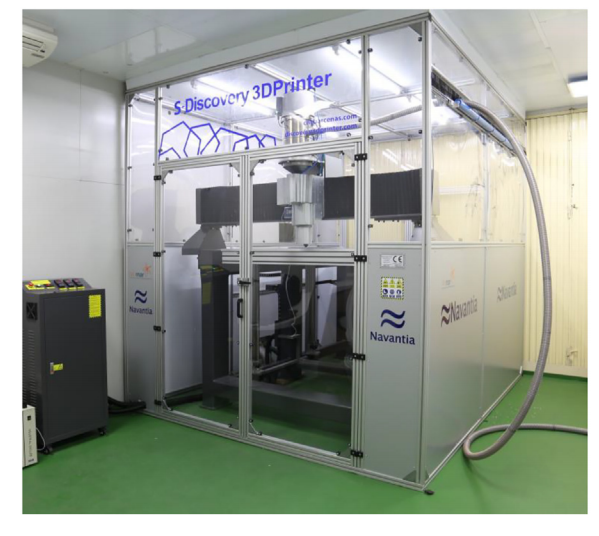
Discovery LFAM device property of Navantia S.A., S.M.E. (placed at Bay of Cadiz Shipyard, Puerto Real, Cádiz, Spain). Adapted from [12].).

Samples printed along the two different configurations studied: a) neat ASA sample printed along X direction outside the printer (XY plane displayed, being the Z-direction perpendicular to the image plane (outwards)); and b) ASA 20CF sample printed along Z direction inside the printer. X, Y and Z directions are indicated at the images.
The following samples were created:
- Five normalized tensile samples
- Five flexural test samples
- Ten non-notched impact pieces
- Two thermal conductivity discs
The composites were examined regarding mechanical, rheological, and thermal properties.
“The mechanical properties were addressed by testing injected tensile, flexural and impact pieces. The melting flow rate (MFR) and the glass transition temperature (Tg), determined by differential scanning calorimetry (DSC), were measured for the two compositions,” explained the authors. “The thermal conductivity was measured using cylindrical injected discs. In a second step, X and Z printed specimens were analyzed by tensile and flexural tests, assessing the influence of the printing orientation in the mechanical properties of both, neat ASA and ASA 20CF.
“Specifically, tensile tested samples were study at the fractured surface of printed specimens aiming to discuss and correlate microstructural features with differentiated mechanical performance of the two materials.”
SEM images show that carbon fibers are well-integrated into the polymer matrix, occurring even after the tensile test.
“A pronounced anisotropy, negligible in injected pieces, is observed in the mechanical properties. A maximum UTS of 60 ± 4 MPa is achieved for X orientation in ASA CF composite, while the flexural tests results are similar, even higher, than for injected parts,” concluded the researchers. “This increase might be attributed to the laminar character of the pieces and the preferential alignment of polymer chains.
“A prealignment of the fibers along the printing deposition direction was observed; likely imposing a physical barrier in Z direction avoiding polymer diffusion and explaining this behavior. The addition of CF results in higher roughness porosity and inner-bead porosity, while reducing the inter-bead porosity. The inner-bead is usually considered as an intrinsic defect of extrusion processes, whereas the observed roughness and inter-bead porosity are characteristic of printing procedures.”
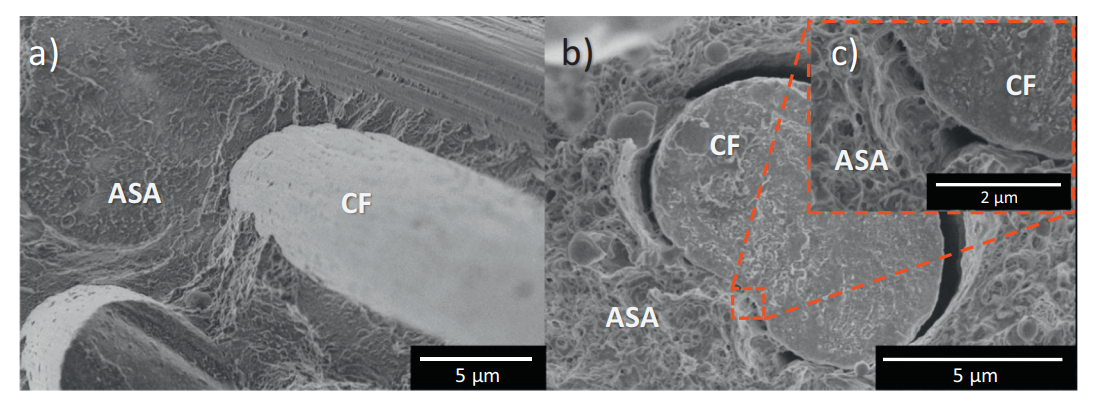
SEM images of the fracture surface of ASA 20CF after a) flexural fracture at liquid nitrogen temperature (without mechanical test); b) tensile test and c) detail of the bonding interface between ASA and CF.
The study of composites continues to expand within the 3D printing realm, as researchers explore a wide variety of materials from bronze PLA composites to products that are bioinspired, to combinations of materials integrated with sensors, and far more.
What do you think of this news? Let us know your thoughts! Join the discussion of this and other 3D printing topics at 3DPrintBoard.com.
[Source / Images: ‘Development of carbon fiber acrylonitrile styrene acrylate composite for large format additive manufacturing’]
The post Carbon Fiber Acrylonitrile Styrene Acrylate Composite (CF-ASA): New Material for Large Format Additive Manufacturing appeared first on 3DPrint.com | The Voice of 3D Printing / Additive Manufacturing.


